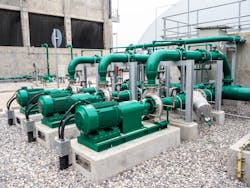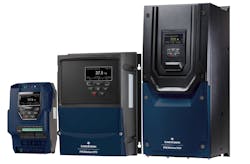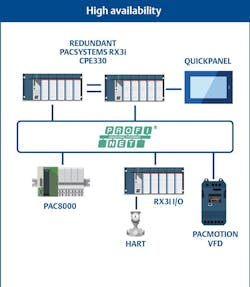Improved VFD redundancy increases uptime
Processing and manufacturing companies everywhere have been transitioning to use variable frequency drives (VFDs) with their motor-driven equipment for many years. Energy savings is the most prominent advantage and leads to fast paybacks, but improved performance and capabilities can result in higher-quality production and are not to be ignored. VFDs can be more complicated to manage, however, than traditional across-the-line starters, so some users may be reluctant to make the move.
Just slapping any VFD into a new or existing piece of equipment probably will not provide the maximum possible benefit. Instead, users should investigate more advanced features like true redundancy up to the controller, along with close integration to controller software. The cost of adding these capabilities is typically outweighed by savings due to increased uptime and ease-of-use for maintenance. The right VFD solutions can help users realize all these benefits, simplify deployment and improve overall reliability — all in a cost-effective manner.
Basic VFD benefits
By now, most end users are familiar with the most basic benefits of using a VFD:
- Energy savings (because loads can be operated at lower-than-maximum speed).
- Soft starting/stopping reduces the wear and tear on driven equipment.
- Full torque at zero speed and short-term overload management to manage load variation without the need to oversize drives for worst-case conditions.
- Communications connectivity enable advanced commanding, along with extensive data monitoring and diagnostics.
- Integrated safe torque off (STO) functionality.
- Advanced control schemes and PID control built into the VFD.
- Capability of using extended I/O, right on the VFD.
These intelligent features, available with a good price/performance ratio and packaged into a small footprint, are more than enough to tip the scales toward using VFDs for most new and retrofit applications.
In addition, the most capable VFDs now go far beyond these capabilities, offering redundancy options and close integration with automation platforms. While many users may not think these qualities are necessary, a closer look reveals their importance.
VFD controller redundancy for more applications
Redundancy has long been considered appropriate for only the most critical or cost-intensive operations. This opinion has now shifted because greatly improved hardware and software technologies for networking and industrial controllers have changed the equation, which should prompt designers to at least consider controller and network redundancy as viable and beneficial for many applications.
In many cases, redundancy at the control and networking level can be added for not much more than the cost of spare components, which would be needed anyway. To make redundancy implementations cost-effective, VFDs must be capable of working natively in redundant configurations.
Just like an across-the-line starter, a traditional VFD by itself is a single point of failure. In many cases, due to the nature of electrical power distribution in a processing facility or on a machine, it has been quite common to connect standard non-intelligent starters and VFDs to localized remote I/O, or even to a dedicated local programmable logic controller (PLC). Either option creates another single point of failure, which can impact many motor controls at once.
Modern VFDs provide onboard intelligence via microprocessors. Therefore, these types of VFDs can communicate directly with their host PLC over a suitable fieldbus network. Using traditional fieldbuses, it has even been possible to provide media redundancy for quite some time. The next step is for designers to consider which media and industrial communications protocol best suits their application.
PROFINET and integration advantages
Today, processing systems and equipment are most likely to use Ethernet as the network media for I/O and intelligent devices, in combination with a communications protocol like EtherNet/IP or PROFINET. While either of these prominent protocols can be used for a redundant VFD installation, there are several distinct advantages for PROFINET.
- Network performance: Because EtherNet/IP duplicates packets to achieve redundancy, half of the available bandwidth is lost. PROFINET uses intelligent network switching, which preserves this bandwidth while still providing redundancy.
- Named devices: The PROFINET protocol allows name-based device access, preferred by plant personnel, as opposed to just using a cryptic IP address.
- Streamlined controller redundancy: PROFINET controller redundancy, while not strictly necessary for VFD network redundancy, allows cybersecurity patches to be applied to controllers one at a time without stopping the application.
While many VFDs support industrial protocols, although not necessarily on redundant media, it is also important to consider how well a VFD integrates with the intended host PLC or edge controllers, which may or may not be redundant themselves.
A generic interface provides basic functionality, although it may require quite a bit of configuration and extra background knowledge by the end user. When VFDs and controllers are selected from a coordinated product family, however, commissioning and operation are greatly simplified.
Consider, for instance, VFDs that incorporate an autotune feature to determine parameters that optimize VFD operation with the connected motor load. When the VFD and controller come from a coordinated product portfolio, users can perform this function as part of the controller software suite, so they do not need to perform this step in the field at the VFD faceplate. This significantly reduces commissioning durations and minimizes field work.
It is also important that key diagnostics are integrated with and readily accessible as part of basic communications methods, so essential device health and status information is available in real-time along with the drive control data. This eliminates the need for complex procedures or external tools to monitor the health and status of operating VFDs.
VFDs commonly contain hundreds of available setup and configuration parameters. Users will find it much easier to access these via a single software toolset common to the controllers, as opposed to entering them into the VFD faceplate directly. Of course, some modern VFDs offer convenient alternatives such as a Bluetooth stick for performing VFD configuration uploads/downloads, enabling tool-less VFD commissioning and replacement.
A preferred processing solution
With the availability of highly capable controllers and VFDs, users are now able to tap into even greater efficiencies and project cost reductions beyond basic energy savings. One end user manufacturing cutting-edge consumer products was accustomed to allocating two days for setup, configuration and optimization tuning of each VFD they deployed in their manufacturing plants. By switching to the latest family of PROFINET-capable VFD from their controls supplier with integrated autotune functionality and integrated commissioning software, they found this previously arduous task reliably reduced to under four hours.
Another end user in the aggregates manufacturing industry, not wanting to impact demanding customer delivery schedules and limited in production operating hours due to local noise ordinances, typically performed certain types of system maintenance, especially cybersecurity upgrades, at night or on weekends on expensive overtime when their plants were not operating. By implementing redundant controllers and VFDs, it became possible to perform this routine maintenance during normal work hours, saving the expense and inconvenience of overtime or outages, improving employee morale and the bottom line.
Intelligent VFDs are today the preferred motor control technology based on energy savings and performance. The availability of cost-effective native redundancy options, and other benefits of coordinating VFD and controller functionality, ensure VFDs can also be easier to deploy and maintain, and will operate more reliably. These types of intelligent VFD solutions will improve almost any process or manufacturing operation in a cost-effective manner.
Darrell Halterman is a director of PACSystems controls products at Emerson’s machine automation solutions business, and he is also responsible for the portfolio’s control solutions modernization strategy. He enjoys working with customers to find the right modernization strategy to enhance their existing control solutions with the latest advancements in automation.
Emerson
About the Author
Darrell Halterman
Darrell Halterman is a senior product manager of PACSystems controllers at Emerson’s machine automation solutions business, and he is responsible for the portfolio’s control solutions modernization strategy. He enjoys working with customers to find the right modernization strategy to enhance their existing control solutions with the latest advancements in automation.


